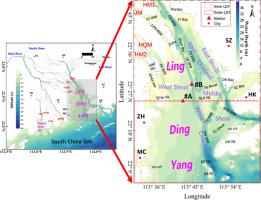On the patterns and mechanisms of residual currents and suspended sediment transport in the Lingdingyang of the Pearl River Delta
引用次数: 0
Abstract
Tide-averaged current, i.e., Eulerian residual current (ERC), indicates net transport of sediment and pollutants in coastal and estuarine regions. In this paper, we examine the dynamics of tidal currents and associate residual currents (RCs), suspended sediment transport and its governing mechanisms in the Lingdingyang (LDY) of the Pearl River Delta based on field data and numerical modeling. Results indicate that seaward ERCs dominate throughout the LDY. The ERCs are greater in the wet seasons than that in the dry seasons. The ERCs are smaller in the middle layer of the water column over the shoals, whereas they ware are larger in the middle layers in deep channels. The ERCs mainly discharge into the sea through the deep channel and west shoal, forming a slack water zone in the middle shoal. Vertical circulation structures of ERCs are controlled by the channel-shoal structure. A dual ERC circulation structure was observed between the channels, which is characterized with seaward and landward ERCs at the surface and bottom layers, respectively. As a result, the residual sediment transports are seaward, with large rates at the shoal than in the channel. Seaward ERCs explain residual sediment transport in the deep channel. Both ERCs and Stokes RCs (SRCs) are important over the shoal. Tidal pumping is of secondary importance and its direction varies over time and in space. These findings provide a scientific basis for understanding the channel-shoal evolution and maintenance of the navigational waterway in the LDY.

论珠江三角洲伶仃洋残流与悬浮泥沙运移的模式与机理
潮汐平均海流,即欧拉剩余海流(ERC),显示了沿岸和河口地区泥沙和污染物的净迁移。本文基于现场数据和数值模拟,研究了珠江三角洲伶仃洋(LDY)潮汐流和相关剩余流(RCs)的动态变化、悬浮泥沙输运及其调控机制。结果表明,在整个伶仃洋,向海的ERCs占主导地位。雨季的 ERC 比旱季大。滩涂水体中层的ERC较小,而深槽水体中层的ERC较大。ERC 主要通过深槽和西侧滩涂排入大海,并在中层滩涂形成一个淡水区。ERC 的垂直环流结构受水道-滩涂结构的控制。在航道之间观察到了双重 ERC 循环结构,其特点是表层和底层分别有向海和向陆的 ERC。因此,残余泥沙向海运输,滩涂的运输速率大于河道。向海的 ERC 可解释深槽中的残余泥沙运移。滩涂上的 ERC 和斯托克斯 RC(SRC)都很重要。潮汐抽吸作用次之,其方向随时间和空间而变化。这些发现为了解澜沧江大洋航道滩涂演变和航道维护提供了科学依据。
本文章由计算机程序翻译,如有差异,请以英文原文为准。
求助全文
约1分钟内获得全文
求助全文

 求助内容:
求助内容: 应助结果提醒方式:
应助结果提醒方式:


